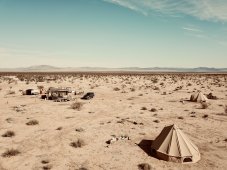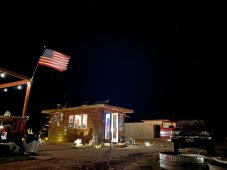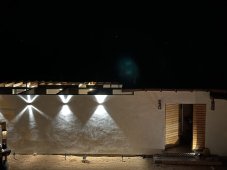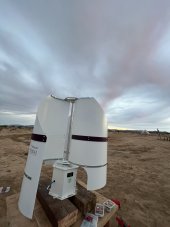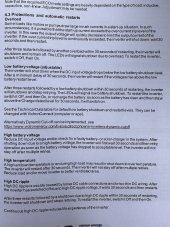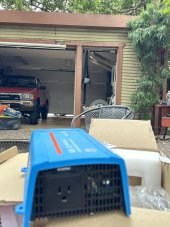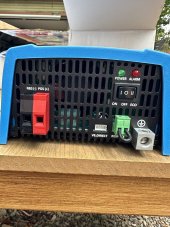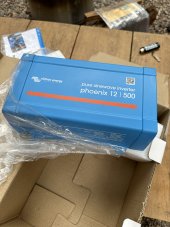thesundayranch
New Member
Hey solar nerd friends. First time posting here - but I have been working on and installing my solar / wind hybrid off grid system in the remote desert of Joshua Tree for the past year.... and have learned A LOT. (will post more in other threads about some of the challenges I have hacked my way through)...
BUT - my most recent challenge is this: although I have (on paper) more than enough batter capacity and solar output to prevent this from happening (details below) - the power at the ranch keeps going out when I am not there to baby it. I know this because I have a SimpliSafe security system and Google Nest outdoor cameras hooked up to my Starlink internet and when the power goes out - I get notified by both Google Home and SimpliSafe that the wifi is out (meaning power to the wifi has gone out).
Powering the cameras and security system are 4x200ah 12v LifePO4 batteries and the draw from the security system is minimal - maybe 20watts. The draw from the starlink is from 50W-100W depending on how hard its working to connect to satellites.
So - maximum calcs would be:
100W x 24hrs = 2400W / day
20W x 24hrs = 480W / day
So to keep both of these powered and running 24/7 i would only need 2,880Wh and the system is 9600Wh. Even with this - I was encountering issues with power loss and HERE IS THE ISSUE: when my 120v inverter turns off due to low voltage disconnect it will not turn back on unless someone is there to turn it back on (I am only there on weekends to work)
Hoping to fix the situation - I removed the Starlink from the main power supply above and hooked it up to it's own independent power supply which consists of 2x12v 100Ah Gel batteries. So - this gives me the 2400Wh I need to keep the starlink running 24 hours a day and allows for more than enough capacity for the SimpliSafe to run off the original system above. (the starlink does not run at 100W consistently so 2400Wh should be enough to keep it on?)
Anyways this is really annoying because there are desert thieves out there and every time the power goes out I end up having to make a 3 hours trip out there to turn it back on - for fear if I leave it off I will get robbed.
Are there any 120v inverter options out there that have an auto-restart feature? Even one with just a manual switch on/off would work - since I would keep it in the ON position and in theory once the batts charge back up in the morning it should kick back on. I have not found anything that fits this need but I know there has to be something... so that's why I am here!
Anyone have any good reccos for a 120v inverter that will kick back on automatically in the morning when the sun comes back out and starts to recharge the batteries???
BUT - my most recent challenge is this: although I have (on paper) more than enough batter capacity and solar output to prevent this from happening (details below) - the power at the ranch keeps going out when I am not there to baby it. I know this because I have a SimpliSafe security system and Google Nest outdoor cameras hooked up to my Starlink internet and when the power goes out - I get notified by both Google Home and SimpliSafe that the wifi is out (meaning power to the wifi has gone out).
Powering the cameras and security system are 4x200ah 12v LifePO4 batteries and the draw from the security system is minimal - maybe 20watts. The draw from the starlink is from 50W-100W depending on how hard its working to connect to satellites.
So - maximum calcs would be:
100W x 24hrs = 2400W / day
20W x 24hrs = 480W / day
So to keep both of these powered and running 24/7 i would only need 2,880Wh and the system is 9600Wh. Even with this - I was encountering issues with power loss and HERE IS THE ISSUE: when my 120v inverter turns off due to low voltage disconnect it will not turn back on unless someone is there to turn it back on (I am only there on weekends to work)
Hoping to fix the situation - I removed the Starlink from the main power supply above and hooked it up to it's own independent power supply which consists of 2x12v 100Ah Gel batteries. So - this gives me the 2400Wh I need to keep the starlink running 24 hours a day and allows for more than enough capacity for the SimpliSafe to run off the original system above. (the starlink does not run at 100W consistently so 2400Wh should be enough to keep it on?)
Anyways this is really annoying because there are desert thieves out there and every time the power goes out I end up having to make a 3 hours trip out there to turn it back on - for fear if I leave it off I will get robbed.
Are there any 120v inverter options out there that have an auto-restart feature? Even one with just a manual switch on/off would work - since I would keep it in the ON position and in theory once the batts charge back up in the morning it should kick back on. I have not found anything that fits this need but I know there has to be something... so that's why I am here!
Anyone have any good reccos for a 120v inverter that will kick back on automatically in the morning when the sun comes back out and starts to recharge the batteries???





